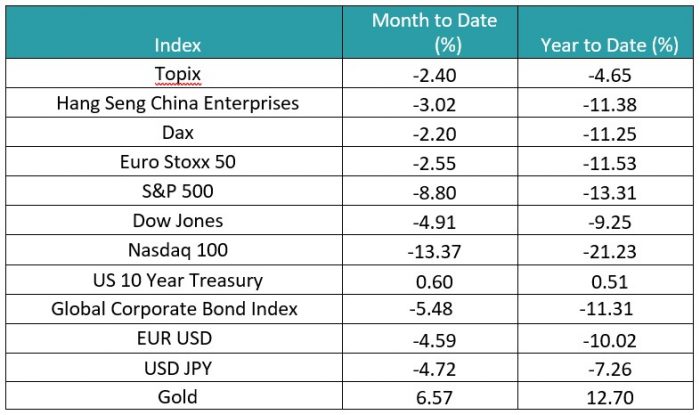MONTHLY NEWSLETTER – APRIL 2022
A summary of key events and market trends during the month of April
- April has been a brutal month for global equities, with the Nasdaq and most large cap tech stocks (Amazon and Alphabet above all) experiencing their worst monthly drawdown since the great financial crisis in 2008. Nasdaq was the most impacted index, losing 13% on the month, resulting in a -21% yearly performance
- At current valuations, most of the pricing in of a hawkish Federal Reserve could be behind us
- As of March we had seen 9 hikes priced in for the next twelve months and we are currently around 10 hikes being factored in taking the Fed Funds rate to slightly over 3 %. Balance sheet contraction by the Fed has also been well telegraphed and would have broadly been factored into expectations
- A surprise quarter-on-quarter US GDP contraction is being explained away by inventory and trade adjustments and personal spending has continued to be robust
- Geopolitical risks continue to be a wild card with the conflict in Ukraine continuing; EU countries are grappling with the right balance to be maintained between supporting Ukraine as well as adjusting the supplies of their energy requirements.
- US corporate results have been mixed with some of the megacap names disappointing and feeling the impact on valuations. The current shape of the yield curve suggests an economic slowdown but long-term growth prospects of many of the technology-oriented industries will unlikely be impacted negatively
- As expected, volatility has moved back to the highs from earlier in the year and the VIX closed around 33. Levered investors in the options markets could see the negative mark to market impact of their positions dictate a reduction in exposures and hence induced selling
Asset markets feeling the impact of Central Bank policy …
The Fed signed off last month on an increasingly hawkish tone … does it keep upping the ante?
Key Markets
Recap of the month …
April 2022 will go down the history books as one of the worst months for the equity markets. The Nasdaq had its worst month since 2008 and the day after announcing its latest results Amazon.com had its worst trading day since 2006.
Corporate earnings and outlooks are clearly in flux as managements attempt to simultaneously bed down issues related to lower liquidity, higher interest rates and inflation, supply chain disruptions and geopolitical concerns. Firms with levered balance sheets will be less able to handle these multiple challenges while companies with strong cash positions and high levels of expected cash flows will fare much better.
The same applies to governments as also with individuals; Sri Lanka is a case in point as are individual investors who were too comfortable with highly leveraged portfolio positions. We expect that some of the price action that has been witnessed this year would have been from forced selling of assets and if and when we see key technical price levels and volatility levels breaking, would induce further sales.
These decreases in the valuations of companies have, in many cases, very little to do with their underlying competitive growth and pricing power. In fact a disjointed economy very often signals strong underlying dynamics for the best technology firms as their products effectively increase productivity and hence tend to rise in demand.
The geopolitical calculus is settling down with EU and NATO countries providing considerable budgetary and military support to Ukraine. The attack on Kyiv turned into a non-starter and military action has shifted to the eastern parts of the country. Having said that, we note that Russian forces have not been able to make much strategic and substantive gains. The situation appears to now be a war of attrition which will likely continue for some time.
China continues to deal with a strong surge of cases from the pandemic and Beijing, while not in full lockdown, has been restricting movement in the capital. The disruption here, in Shanghai and around the country has resulted in further pressure of supply chains. We expect these would ease in the coming months but with a not insignificant impact in the interim.
The US Dollar far from being displaced, as suggested by some commentary, has seen strong appreciation. While we expect this to continue especially against the Japanese Yen and Swiss Franc we would expect volatile two-way price action as some of the move has already played out in record time. The Bank of Japan has committed to buying unlimited quantity of ten year bonds at an yield of 25 basis points and hence has put large downward pressure on the value of the Yen. We expect US appreciation to continue.
The Volatility Index (VIX) has spiked again to the highs of the year and we would expect volatility to be well bid while the market adjusts to the various challenges facing markets. We continue to look for ways to add value to portfolios via option strategies.

